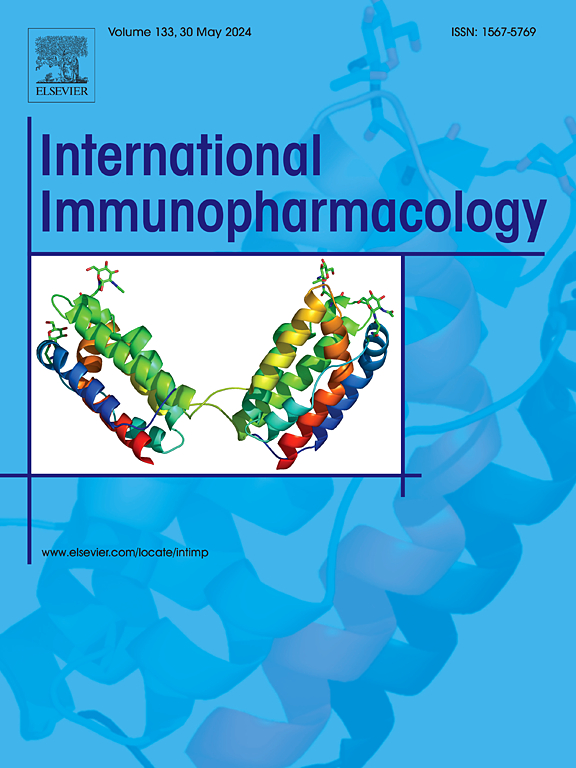基于转录组学和动物实验鉴定肾移植急性排斥反应中调节中性粒细胞胞外陷阱的潜在靶点。
IF 4.8
2区 医学
Q2 IMMUNOLOGY
引用次数: 0
摘要
背景:中性粒细胞胞外陷阱(NETs)已被发现促进炎症反应和加剧组织损伤,并与肾移植急性排斥反应的发生密切相关。采取抗NETs措施对治疗肾移植急性排斥反应具有重要意义。方法:以肾移植急性排斥反应数据集GSE50058为基础,识别与其中NETs调控相关的生物标志物,并使用WGCNA和四种机器学习算法构建诊断模型。我们还利用xCell算法探讨了肾移植急性排斥反应中64种免疫细胞的浸润水平以及nets相关生物标志物与免疫细胞的相关性。同时,我们建立了大鼠肾移植急性排斥反应模型,并在动物实验中验证了生物标志物的表达。最后,我们还通过向大鼠尾静脉注射腺相关病毒,探讨了其中一种生物标志物在NETs调控中的作用。结果:在这项研究中,我们确定了肾移植急性排斥反应中的四种nets相关生物标志物:GPX3、B2M、CDK1和MAP3K5。其中GPX3的表达与肾移植急性排斥反应呈负相关,其余3个标志物与急性排斥反应呈正相关。我们基于上述四种生物标志物构建了诊断模型,ROC曲线和标定曲线均证明了该模型具有良好的诊断价值,DCA曲线证实了四种生物标志物的临床决策能力。xCell算法鉴定出在肾移植急性排斥反应中浸润水平显著改变的20种免疫细胞,其中4种生物标志物的表达与多种免疫细胞密切相关。在动物实验中,这四种生物标志物的表达水平与数据集GSE50058中分析的结果一致。最后,我们还通过动物实验发现,过表达GPX3可以抑制肾组织NETs的激活,减少炎症因子的分泌,从而减轻肾移植急性排斥反应引起的肾组织损伤。结论:GPX3、B2M、CDK1和MAP3K5是肾移植急性排斥反应中NETs相关的生物标志物。其中GPX3在肾移植急性排斥反应中可抑制NETs的激活,降低炎症因子的表达,从而减轻肾组织损伤。本文章由计算机程序翻译,如有差异,请以英文原文为准。
Identification of potential targets regulating neutrophil extracellular traps in acute rejection of kidney transplantation based on transcriptomics and animal experiments
Background
Neutrophil extracellular traps (NETs) have been found to promote inflammatory responses and exacerbate tissue damage, as well as to be strongly associated with the development of acute rejection in kidney transplantation. Taking measures against NETs is important for the treatment of acute rejection in kidney transplantation.
Methods
We used the kidney ransplantation acute rejection dataset GSE50058 as a basis for identifying biomarkers associated with the regulation of NETs therein and constructing a diagnostic model using WGCNA and four machine learning algorithms. We also explored the infiltration levels of 64 immune cells and the correlation between NETs-related biomarkers and immune cells in acute rejection of kidney transplants using the xCell algorithm. Meanwhile, we established a rat kidney ransplantation acute rejection model and validated the expression of biomarkers in animal experiments. Finally, we also explored the role of one of the biomarkers in the regulation of NETs by injecting adeno-associated viruses into the tail vein of rats.
Results
In this study, we identified a total of four NETs-associated biomarkers in acute rejection of kidney transplantation: GPX3, B2M, CDK1 and MAP3K5. Among them, the expression of GPX3 was negatively correlated with acute rejection of kidney transplantation, while the remaining three markers were positively correlated with acute rejection. We constructed a diagnostic model based on the above four biomarkers, and both the ROC curve and the calibration curve proved the good diagnostic value of the model, and the DCA curve confirmed the clinical decision-making ability of the four biomarkers. The xCell algorithm identified 20 types of immune cells with significantly altered infiltration levels in acute rejection of kidney transplants, and the expression of four biomarkers was strongly associated with multiple immune cells. In animal experiments, the expression levels of the four biomarkers were consistent with the results analyzed in the dataset GSE50058. Finally, we also found through animal experiments that overexpression of GPX3 could inhibit the activation of NETs in renal tissues and reduce the secretion of inflammatory factors, thereby alleviating renal tissue injury caused by acute rejection of kidney transplantation.
Conclusion
GPX3, B2M, CDK1 and MAP3K5 as biomarkers associated with NETs in acute rejection of kidney transplantation. Among them, GPX3 can inhibit the activation of NETs and reduce the expression of inflammatory factors in the acute rejection of kidney transplantation, thus alleviating renal tissue injury.
求助全文
通过发布文献求助,成功后即可免费获取论文全文。
去求助
来源期刊
CiteScore
8.40
自引率
3.60%
发文量
935
审稿时长
53 days
期刊介绍:
International Immunopharmacology is the primary vehicle for the publication of original research papers pertinent to the overlapping areas of immunology, pharmacology, cytokine biology, immunotherapy, immunopathology and immunotoxicology. Review articles that encompass these subjects are also welcome.
The subject material appropriate for submission includes:
• Clinical studies employing immunotherapy of any type including the use of: bacterial and chemical agents; thymic hormones, interferon, lymphokines, etc., in transplantation and diseases such as cancer, immunodeficiency, chronic infection and allergic, inflammatory or autoimmune disorders.
• Studies on the mechanisms of action of these agents for specific parameters of immune competence as well as the overall clinical state.
• Pre-clinical animal studies and in vitro studies on mechanisms of action with immunopotentiators, immunomodulators, immunoadjuvants and other pharmacological agents active on cells participating in immune or allergic responses.
• Pharmacological compounds, microbial products and toxicological agents that affect the lymphoid system, and their mechanisms of action.
• Agents that activate genes or modify transcription and translation within the immune response.
• Substances activated, generated, or released through immunologic or related pathways that are pharmacologically active.
• Production, function and regulation of cytokines and their receptors.
• Classical pharmacological studies on the effects of chemokines and bioactive factors released during immunological reactions.

 求助内容:
求助内容: 应助结果提醒方式:
应助结果提醒方式:


